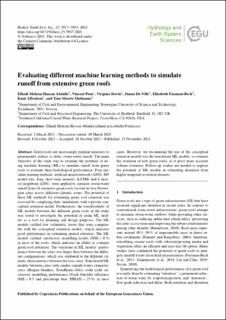| dc.contributor.author | Hassan Abdalla, Elhadi Mohsen | |
| dc.contributor.author | Pons, Vincent | |
| dc.contributor.author | Stovin, Virginia | |
| dc.contributor.author | De-Ville, Simon | |
| dc.contributor.author | Fassman-Beck, Elisabeth | |
| dc.contributor.author | Alfredsen, Knut | |
| dc.contributor.author | Muthanna, Tone Merete | |
| dc.date.accessioned | 2021-11-16T08:56:00Z | |
| dc.date.available | 2021-11-16T08:56:00Z | |
| dc.date.created | 2021-11-15T09:23:37Z | |
| dc.date.issued | 2021 | |
| dc.identifier.citation | Hydrology and Earth System Sciences. 2021, 25 (11), 5917-5935. | en_US |
| dc.identifier.issn | 1027-5606 | |
| dc.identifier.uri | https://hdl.handle.net/11250/2829733 | |
| dc.description.abstract | Green roofs are increasingly popular measures to permanently reduce or delay storm-water runoff. The main objective of the study was to examine the potential of using machine learning (ML) to simulate runoff from green roofs to estimate their hydrological performance. Four machine learning methods, artificial neural network (ANN), M5 model tree, long short-term memory (LSTM) and k nearest neighbour (kNN), were applied to simulate storm-water runoff from 16 extensive green roofs located in four Norwegian cities across different climatic zones. The potential of these ML methods for estimating green roof retention was assessed by comparing their simulations with a proven conceptual retention model. Furthermore, the transferability of ML models between the different green roofs in the study was tested to investigate the potential of using ML models as a tool for planning and design purposes. The ML models yielded low volumetric errors that were comparable with the conceptual retention models, which indicates good performance in estimating annual retention. The ML models yielded satisfactory modelling results (NSE >0.5) in most of the roofs, which indicates an ability to estimate green roof detention. The variations in ML models' performance between the cities was larger than between the different configurations, which was attributed to the different climatic characteristics between the four cities. Transferred ML models between cities with similar rainfall events characteristics (Bergen–Sandnes, Trondheim–Oslo) could yield satisfactory modelling performance (Nash–Sutcliffe efficiency NSE >0.5 and percentage bias |PBIAS| <25 %) in most cases. However, we recommend the use of the conceptual retention model over the transferred ML models, to estimate the retention of new green roofs, as it gives more accurate volume estimates. Follow-up studies are needed to explore the potential of ML models in estimating detention from higher temporal resolution datasets. | en_US |
| dc.language.iso | eng | en_US |
| dc.publisher | European Geosciences Union | en_US |
| dc.rights | Navngivelse 4.0 Internasjonal | * |
| dc.rights.uri | http://creativecommons.org/licenses/by/4.0/deed.no | * |
| dc.title | Evaluating different machine learning methods to simulate runoff from extensive green roofs | en_US |
| dc.type | Peer reviewed | en_US |
| dc.type | Journal article | en_US |
| dc.description.version | publishedVersion | en_US |
| dc.source.pagenumber | 5917-5935 | en_US |
| dc.source.volume | 25 | en_US |
| dc.source.journal | Hydrology and Earth System Sciences | en_US |
| dc.source.issue | 11 | en_US |
| dc.identifier.doi | 10.5194/hess-25-5917-2021 | |
| dc.identifier.cristin | 1954464 | |
| cristin.ispublished | true | |
| cristin.fulltext | original | |
| cristin.qualitycode | 2 | |

